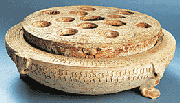 Period:Warring States Period (475-221BC)
Period:Warring States Period (475-221BC)
Listed in: 2004
Excavated by: the Archeological Research Institute of Nanjing Museum; the Cultural Relics Administration of Xishan District, Wuxi City
Archeological team leader: Zhang Min
 Site description
Site description
The site gives people the very first complete picture of the burial rule for the nobles of the Yue Kingdom to be interred in one tomb area in the Spring and Autumn Period(770-446BC). The tombs are of small, medium, large, and extra-large sizes, representing five classifications of noble tombs at that time. More than 2,000 pieces of burial articles were found from the seven excavated tombs.
One of the tombs at Qiuchengdun stretches some 57 meters long in the shape of the Chinese character "中" (center). It is an extra-large one for a noble of the Yue Kingdom, which is next only to the tomb of the King of Yue at Yinshan,Shaoxing in size. It is also the second largest tomb with a total finding of 1,100 burial articles. More strikingly, the unearthed 500-odd porcelain musical instruments in 10 varieties make the tombs the largest underground storehouse of ancient instruments ever discovered.
A good many high-grade celadon (a kind of Chinese pottery) sacrificial vessels, musical instruments, and jade wares are confirmed as being discovered for the first time, such as the recorded musical instrument of "fou," a kind of clay musical instrument whose existence was confirmed for the first time.
 The site can be compared, in terms of number and variety of musical instruments, with the Mausoleum of Marquis Yi of Zeng State (around 433BC), which is famous for its Zeng Houyi Bells, the largest set of bronze bells excavated in the world, and its stone chimes.
The site can be compared, in terms of number and variety of musical instruments, with the Mausoleum of Marquis Yi of Zeng State (around 433BC), which is famous for its Zeng Houyi Bells, the largest set of bronze bells excavated in the world, and its stone chimes.
The site's four circular-shaped pottery pieces with red, blue, and white glazes and eight sculpted snakes circling the body are rare research materials on the origin of glass and the cultural exchanges between China and foreign countries.
 Significance
Significance
The tomb site dates back to the early years of the Warring States Period (475-221BC), possibly when the immortalized King Goujian of the State of Yue took the throne in 496 BC. The findings mark the most important archaeological discovery on the State of Yue to date, with abundant relics of the highest grade, best texture, and most complete varieties. The site not only has far-reaching significance on the study of Yue history and culture, but may also help rewrite part the ancient history of not only this region, but also that of music and porcelain making.
